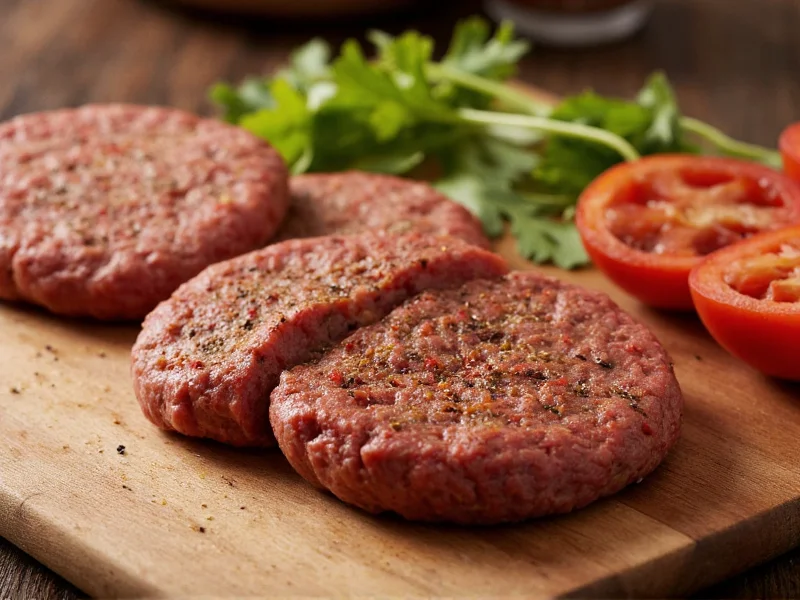The Science Behind Effective Burger Seasoning
Understanding how seasoning interacts with ground beef is crucial for perfect burgers. Salt doesn't just add flavor—it alters the meat's protein structure, helping retain moisture during cooking. When applied properly, salt dissolves some muscle proteins which then form a gel that traps juices. This scientific process explains why timing matters: seasoning too far in advance (more than 20 minutes) causes moisture loss through osmosis, while seasoning immediately before cooking preserves that precious juiciness.
Umami compounds in ingredients like garlic powder and onion powder enhance the natural savory notes in beef without overpowering its distinctive flavor. Unlike fresh garlic or onion, the powdered forms distribute evenly throughout the meat without creating hot spots or burning during cooking.
Essential Burger Seasoning Components
Creating the ideal burger seasoning requires understanding each component's role. The foundation consists of just four ingredients that work synergistically:
| Ingredient | Function | Recommended Ratio (per lb beef) |
|---|---|---|
| Kosher salt | Moisture retention, flavor enhancement | 3/4 teaspoon |
| Freshly ground black pepper | Complex flavor, subtle heat | 1/4 teaspoon |
| Garlic powder | Umami boost, aromatic complexity | 1/8 teaspoon |
| Onion powder | Sweetness, depth of flavor | 1/8 teaspoon |
Homemade Burger Seasoning Recipes
While the basic blend works for most applications, customizing your burger seasoning for specific flavor profiles elevates your burgers from ordinary to exceptional. These versatile burger seasoning blends cater to different preferences while maintaining the essential salt-to-spice balance:
Classic All-Purpose Burger Seasoning
Mix 1/4 cup kosher salt, 2 tablespoons freshly ground black pepper, 1 tablespoon garlic powder, and 1 tablespoon onion powder. This fundamental burger seasoning ratio provides balanced flavor that complements rather than competes with quality beef. Store in an airtight container for up to six months—though it rarely lasts that long in most households.
Smoky Southwest Burger Blend
For those seeking bold burger seasoning variations, combine the classic blend with 2 teaspoons smoked paprika, 1 teaspoon cumin, and 1/2 teaspoon chipotle powder. This southwestern burger seasoning works particularly well with chuck or brisket blends, adding complexity without overwhelming the beef's natural flavor.
When and How to Apply Burger Seasoning
The timing of seasoning application significantly impacts your burger's texture and juiciness. Contrary to popular belief among home cooks, the optimal moment to apply burger seasoning is immediately before the patties hit the cooking surface. This timing prevents salt from drawing out moisture prematurely while still allowing flavor penetration during the brief cooking process.
For even distribution without overworking the meat, gently mix the seasoning into the ground beef using your fingertips. Avoid kneading the meat as this develops proteins that can make burgers tough. Alternatively, sprinkle seasoning evenly over formed patties just before cooking for surface flavor without affecting texture.
Common Burger Seasoning Mistakes to Avoid
Even experienced grill masters make critical errors with burger seasoning that compromise results. Understanding these pitfalls helps achieve consistently excellent burgers:
- Over-seasoning with salt—exceeding 1% salt by weight makes burgers unpleasantly salty while drawing out excessive moisture
- Using table salt instead of kosher—table salt's finer crystals and higher density lead to inconsistent seasoning and potential over-salting
- Adding fresh garlic or onion—these burn easily during cooking, creating bitter flavors that dominate the burger
- Seasoning too early—applying salt more than 20 minutes before cooking initiates moisture loss through osmosis
- Ignoring meat quality—premium seasoning can't compensate for poor-quality ground beef with inappropriate fat content
Troubleshooting Burger Seasoning Issues
When your burgers don't turn out as expected, these solutions address common seasoning-related problems:
Bland-tasting burgers: Increase salt content slightly (by 10-15%) or add a pinch of MSG to enhance umami. Remember that fat carries flavor, so using meat with appropriate fat content (15-20%) significantly impacts perceived seasoning effectiveness.
Overly salty burgers: Balance with a touch of acidity—serve with pickles or a squeeze of lemon. For future batches, reduce salt by 25% and consider adding unsalted ingredients like grated onion to dilute seasoning concentration without compromising texture.
Burnt seasoning: Lower cooking temperature slightly and avoid seasonings with sugar content that caramelizes too quickly. Apply seasoning after the initial sear if using blends containing paprika or other heat-sensitive ingredients.











 浙公网安备
33010002000092号
浙公网安备
33010002000092号 浙B2-20120091-4
浙B2-20120091-4